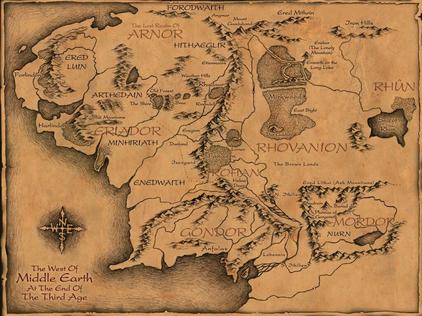 By Eileen Wiedbrauk. In an NPR essay, Saladin Ahmed wrote of the lynch pin of epic fantasy world building: the map. For works of second world fantasy, the inclusion of the map once was a splendid means of entry into a new world. Then it became so ubiquitous that yet another tired old map that looked vaguely like Europe with a few extra lumps and bumps neared the status of a joke. I can recall conversations from the past decade when my fantasy-reading friends would hear a certain speculative novel was bland, and they'd immediately ask: "Did it have a map?" A derisive snort followed. Of course, in the decade preceding that, I would buy only books that had maps between their end papers and opening chapters. No map, no deal. How quickly our tastes change. More than anything, the search for a map was a search for comfort. A means of spotting familiar territory on packed bookshelves. The map was a promise of what sort of story was within: swords, quests, most likely magic. It was the marker for a place I called home. Where my reading-self kicked off her boots and put up her feet. I've since come to a place where I see no such absolutes, no need for either map inclusion or exclusion. I've lately started to feel that among new novels, the urban fantasies have more maps than the second world fantasies. But the existence of the map -- so long as it's accurate to the novel's description -- remains, in many but not all cases, a marker of thorough world building. How are we to believe you've done your homework for a realistic set of trials, or a logic-based magic system we can buy into, or indeed, for what "the orcs' loincloths are made out of," if you haven't first planned out the lay of the physical land to house the assorted narrative tchotchkes? Authors should create maps when they write -- functional, not necessarily decorative or elegant maps. Whether the reader ever needs to see that aspect of raw world building is up to the publisher. Yet we must wonder where the line between thorough world building and too much world building exists -- if it does at all. Ahmed points to the fact that Wheel of Time, with its fourteen door-stopper installments (long even by fantasy standards), is "a sort of perennial target of parody, even among die-hard fans, padded as it can be with relentless descriptions of clothing, hairstyles, furniture and food." Wheel of Time is, in fact, the series that accustomed me to a multi-page glossary/appendix at the back of the book. Even with that glossary, I reached a point with the Wheel of Time series when I picked up the new book after a year of waiting for it to come out, and I could no longer recall all the characters, whether it was by name or deed or motivation or location. A crisis of memory further compound by there being a certain number of characters who are acting as spies and double agents under assumed identities. The down time between one release and the next was more than enough to rob me of the myriad of minor details (some of which were important) that the reader was expected to recall if she wanted it all to make sense. So I gave up. Not on the series, but on the game of remembrance. Twelve years ago, I decided to wait for the end of the series to arrive and then to ... start over. With book one. In January 2013, A Memory of Light, book fourteen in the Wheel of Time series started by Robert Jordan in 1990, hit the shelves. The final book. In the truest meaning of a never-ending wheel, the end is the impetus: It's time to start again. And, as Ahmed points out, I'm certain that sooner or later, keeping track of everything will feel like homework. But homework for a favorite class.  Eileen Wiedbrauk, Editor-in-Chief Eileen Wiedbrauk is an editor, writer, coffee addict, cat herder, MFA graduate, fantasist-turned-fabalist-turned-urban-fantasy-junkie, Odyssey Workshop alumna, photographer, designer, tech geek, entrepreneur, avid reader, and a somewhat decent cook. She wears many hats, as the saying goes. Which is an odd saying in this case, as she rarely looks good in hats. eileenwiedbrauk.com
2 Comments
7/15/2014 03:28:12 am
I make maps as part of my world-building. If I don't have a map, it's too easy for me to forget where things are while I'm writing about them. For me, maps actually enhance my description, because they remind me of the terrain my characters are traveling, the political effects of having a mountain range cutting through the heart of your kingdom, or the reasons a city became so important to trade routes.
Reply
7/22/2014 11:36:01 pm
Thanks for your comment, Stephanie. I can completely understand how having a visual reference while building a world that isn't tangible except in the mind, is an absolute must for many people!
Reply
Your comment will be posted after it is approved.
Leave a Reply. |
World Weaver PressPublishing fantasy, paranormal, and science fiction. Archives
February 2024
|
- Home
-
Books
-
All Books
>
- Beyond the Glass Slipper
- Bite Somebody
- Bite Somebody Else
- Black Pearl Dreaming
- Cassandra Complex
- Causality Loop
- Clockwork, Curses, and Coal
- Continuum
- Corvidae
- Cursed: Wickedly Fun Stories
- Dream Eater
- Equus
- Fae
- Falling of the Moon
- Far Orbit
- Far Orbit Apogee
- Fractured Days
- Frozen Fairy Tales
- Glass and Gardens: Solarpunk Summers
- Glass and Gardens: Solarpunk Winters
- Grandmother Paradox
- Grimm, Grit, and Gasoline
- Haunted Housewives
- Heir to the Lamp
- He Sees You When He's Creepin': Tales of Krampus
- Into the Moonless Night
- Jack Jetstark's Intergalactic Freakshow
- King of Ash and Bones (ebook)
- Krampusnacht
- Last Dream of Her Mortal Soul
- Meddlers of Moonshine
- Mothers of Enchantment
- Mrs Claus
- Multispecies Cities
- Murder in the Generative Kitchen
- Recognize Fascism
- Scarecrow
- Sirens
- Shards of History
- Shattered Fates
- Skull and Pestle
- Solarpunk (Translation)
- Solarpunk Creatures
- Solomon's Bell
- SonofaWitch!
- Speculative Story Bites
- Trenchcoats, Towers, and Trolls
- Weredog Whisperer
- Wolves and Witches
- Anthologies and Collections
- Novels
- Novellas
- Fairy Tale
- Fantasy
- Romance
- Science Fiction
- Urban/Contemporary Fantasy
- Young Adult SFF
-
All Books
>
- Blog
- About
- Contact
- Press / Publicity
- Newsletter Signup
- Privacy Policy
- Store

 RSS Feed
RSS Feed